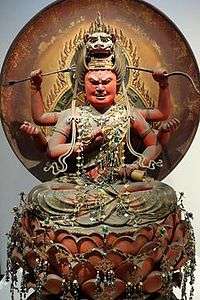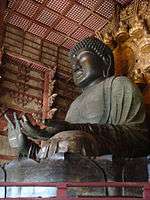Rāgarāja
Rāgarāja (Sanskrit: रागराज; simplified Chinese: 爱染明王; traditional Chinese: 愛染明王; pinyin: Àirǎn Míngwáng, Japanese: 愛染明王, romanized: Aizen Myō'ō) is a dharmapala deity from the Esoteric and Vajrayana Buddhist traditions. He is especially venerated in the Tang Esoteric schools and its descendants, particularly Shingon and Tendai in Japan.
| Rāgarāja | |||||||||||
|---|---|---|---|---|---|---|---|---|---|---|---|
 Ragaraja at Tokyo National Museum, Japan | |||||||||||
| Chinese name | |||||||||||
| Traditional Chinese | 愛染明王 | ||||||||||
| Simplified Chinese | 爱染明王 | ||||||||||
| |||||||||||
| Korean name | |||||||||||
| Hangul | 애염명왕 | ||||||||||
| Hanja | 愛染明王 | ||||||||||
| |||||||||||
| Japanese name | |||||||||||
| Kanji | 愛染明王 | ||||||||||
| |||||||||||
| Sanskrit name | |||||||||||
| Sanskrit | Rāgarāja | ||||||||||
Nomenclature
Rāgarāja is known to transform worldly lust into spiritual awakening. Originally a Hindu deity, he was adapted as a dharmapala and Wisdom King. When scriptures related to him reached China during the Tang dynasty, his Sanskrit name was translated as Àirǎn Míngwáng "Love-stained Wisdom King". In Japanese, it is written the same way in Kanji but pronounced as Aizen Myō'ō.
Depiction
Rāgarāja, also known as Aizen-Myōō, is one of the five Wisdom Kings like Acala (Fudo-Myōō). There are four different mandalas associated with Rāgarāja: The first posits him with thirty-seven assistant devas, the second with seventeen. The other two are special arrangements: one made by Enchin, fourth Tendai patriarch; the other is a Shiki mandala which represents deities using their mantra seed syllables drawn in bonji. Rāgarāja is also depicted in statuary and thangka having two heads: Rāgarāja and Acala or Rāgarāja and Guanyin, both iterations symbolizing a commingling of subjugated, complementary energies, typically male/female but also Male/male. There are two, four or six armed incarnations of Rāgarāja but the six-armed one is the most common. Those six arms bear a bell which calls one to awareness; a vajra, the diamond that cuts through illusion, an unopened lotus flower representing the power of subjugation, a bow and arrows (sometimes with Rāgarāja shooting the arrow into the heavens), and the last one holding something that we cannot see (referred to by advanced esoteric practitioners as "THAT".)[1] Rāgarāja is most commonly depicted sitting in full lotus position atop an urn that ejects jewels showing beneficence in granting wishes.
He is portrayed as a red-skinned man with a fearsome appearance, a vertical third eye and flaming wild hair that represents rage, lust and passion. Also the Lustful-Tinted Wisdom King was popular amongst Chinese tradesmen who worked in the fabric-dying craft, typically accomplished with sorghum. He is still venerated as a patron of landlords, prostitutes, homosexuals and petitioned by devotees for a peaceful home and abundant fortune in business. There is usually a lion's head on top of his head in his hair, representing the mouth into which thoughts and wishes may be fed. Some of these are the wishes of local devotees who make formal requests for success in marriage and sexual relations. According to the "Pavilion of Vajra Peak and all its Yogas and Yogins Sutra" with the abbreviated name of the "Yogins Sutra" (likely an apocryphal work attributed to the great Buddhist patriarch Vajrabodhi) Rāgarāja represents the state at which harnessed sexual excitement or agitation—which are otherwise decried as defilements—are seen as equal to enlightenment "bonno soku bodai," and passionate love can become compassion for all living things.[2]
Rāgarāja is similar to the red form of Tara, called Kurukulla, in Tibetan Buddhism. Appropriately, Rāgarāja's mantras are pronounced in either Chinese or Japanese transliterations of Sanskrit; the cadences depending upon the respective region where his devotees reside and practice, and whether in the Shingon or Tendai schools. His seed vowel, as written in bonji, is pronounced "HUM," usually with a forceful emphasis coming from the use of lower belly muscles. This is part of the syncretic practice of mixing Tantra and Buddhism as was popular during his heyday in Heian period courts and amongst the lower classes of both China and Japan. His popularity in Japan reached an apogee when a Shingon priest used magical chants and rituals to call up the Kamikaze that protected the Japanese from sea-born invaders.[3]
Examples of his mantras can be found on YouTube. When reciting Ragaraja Mantra, Hum。zha-zhi-hum。re, pause after first hum which is recited as a single syllable. Recite the three syllables zha-zhi-hum together. One then recites re as the last single syllable. Do not recite the second syllable hum and last re together.
To invoke Ragaraja, one forms Ragaraja Mudra and recites Ragaraja Mantra, Hum。zha-zhi-hum。re. The invocation technique is to rub the middle fingers together. This represents Ragaraja's love for making connections. If one invokes Ragaraja in this way, he will come quickly and naturally descend into one's body. This is the key cultivation formula.
References
- Grotenhuis, Elizabeth Ten (1999). Japanese mandalas: representations of sacred geography. University of Hawaii Press. ISBN 0-8248-2000-2.
- Goepper, Roger (1993). Aizen-Myōō: The Esoteric King of Lust: An Iconological Study. Artibus Asiae Publishers. ISBN 9783907070512. JSTOR 1522701.
- Goepper, Roger (1993). Aizen-Myōō: The Esoteric King of Lust: An Iconological Study. Artibus Asiae Publishers. ISBN 9783907070512. JSTOR 1522701.
External links

